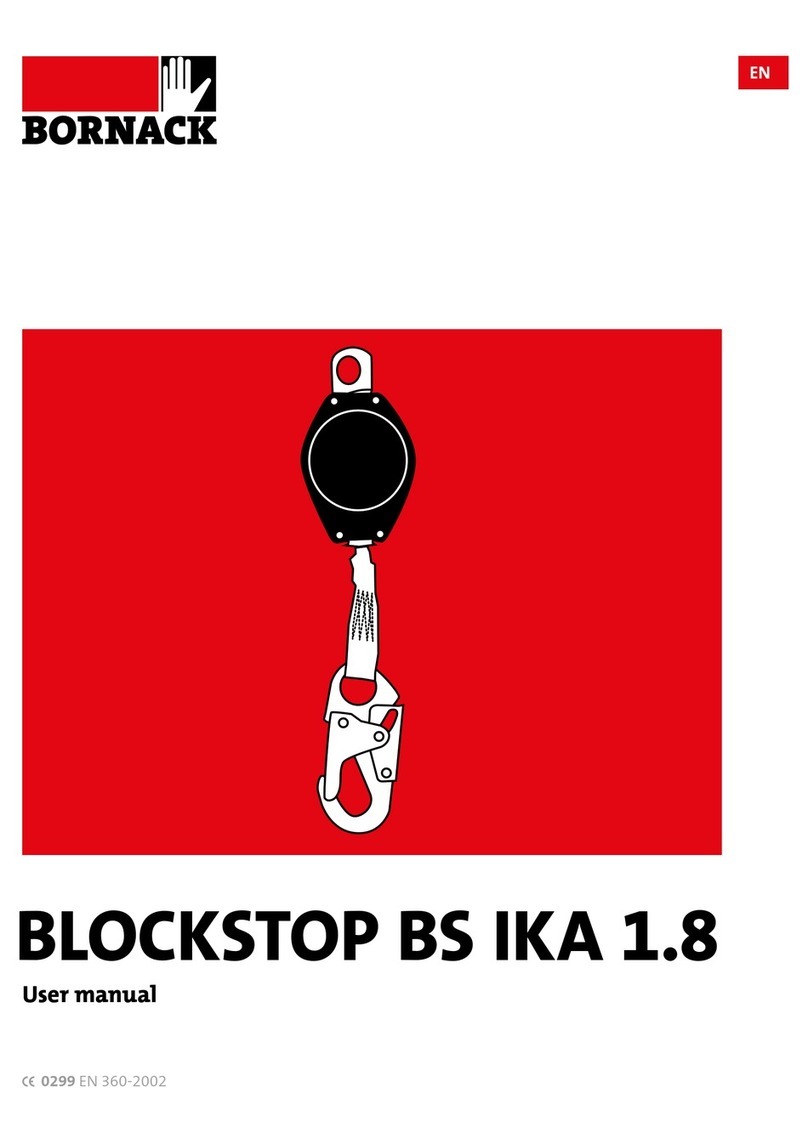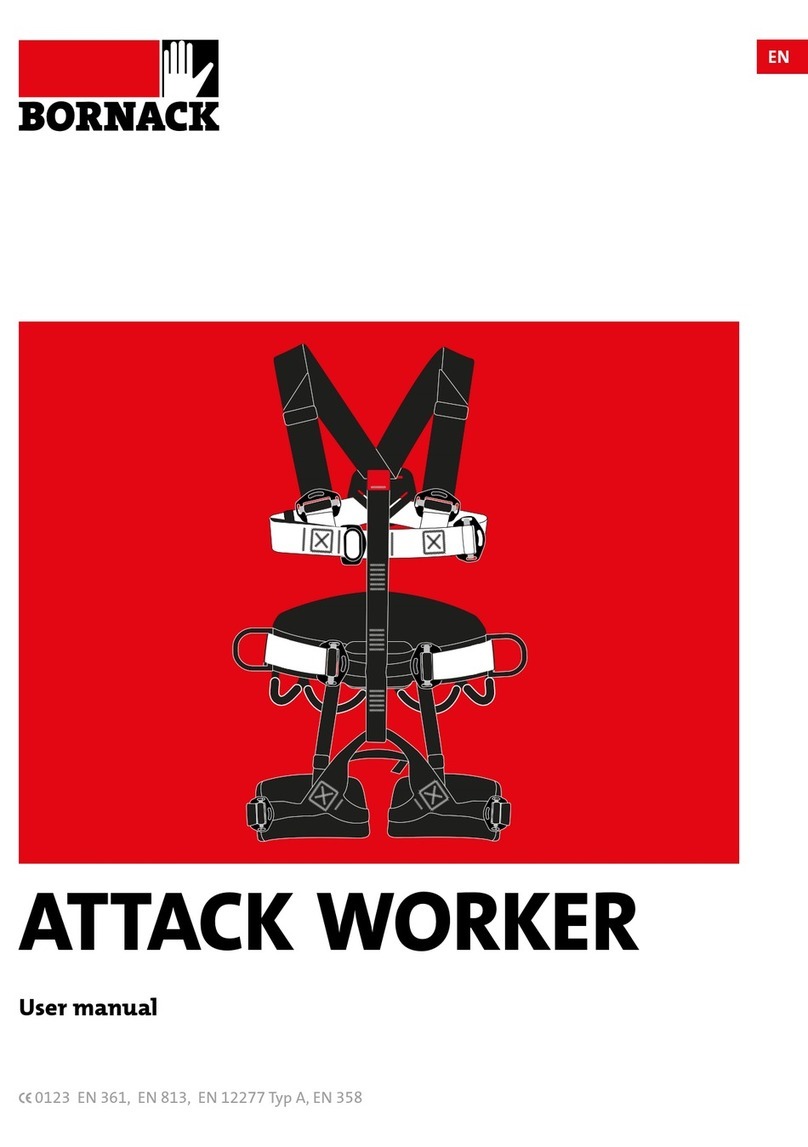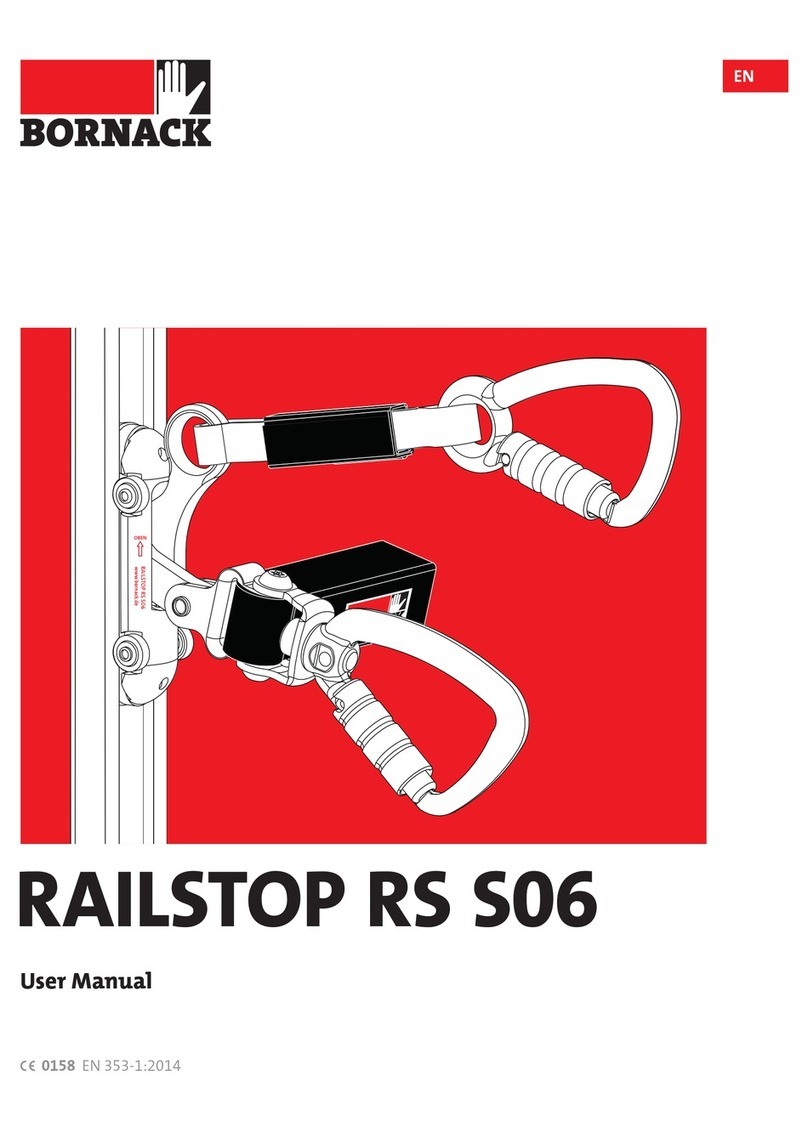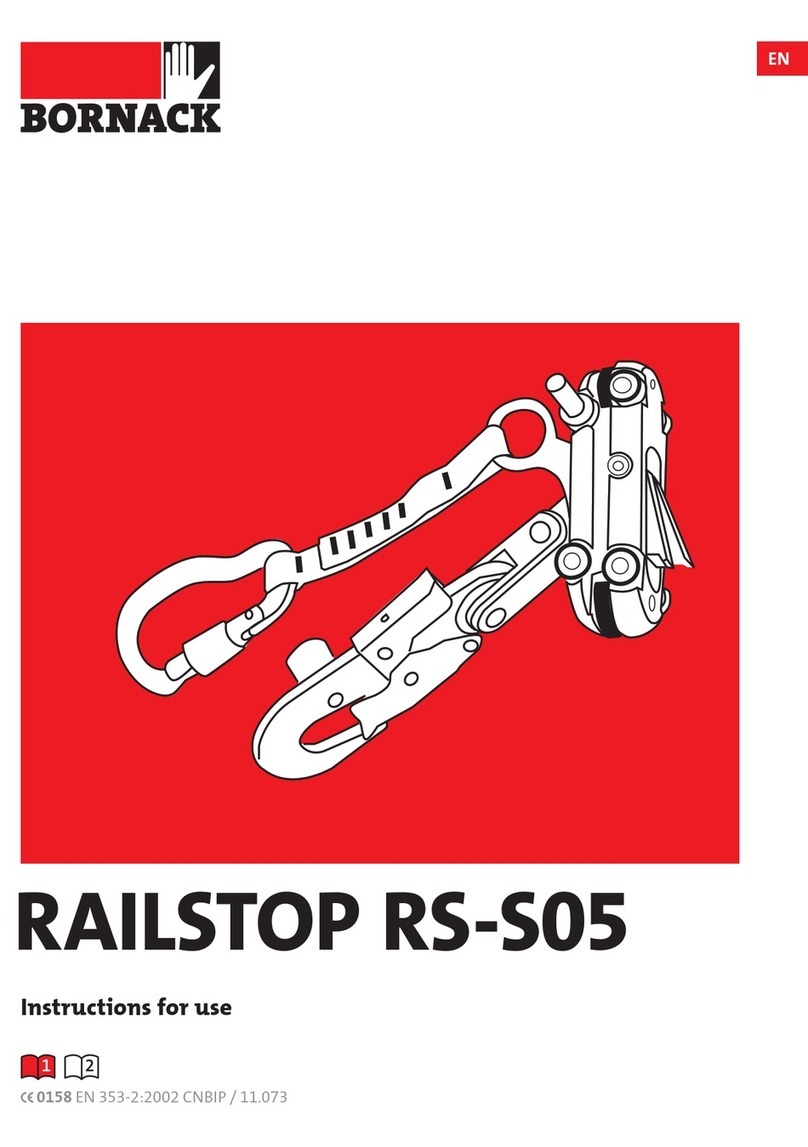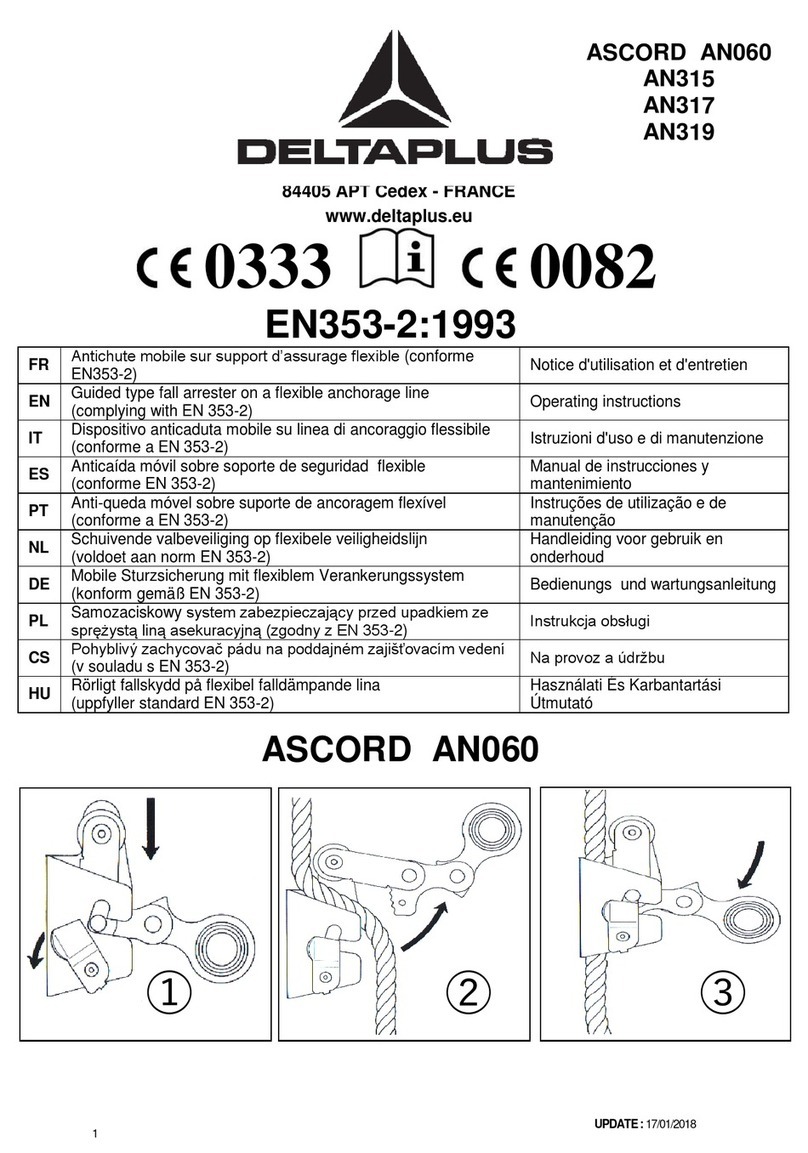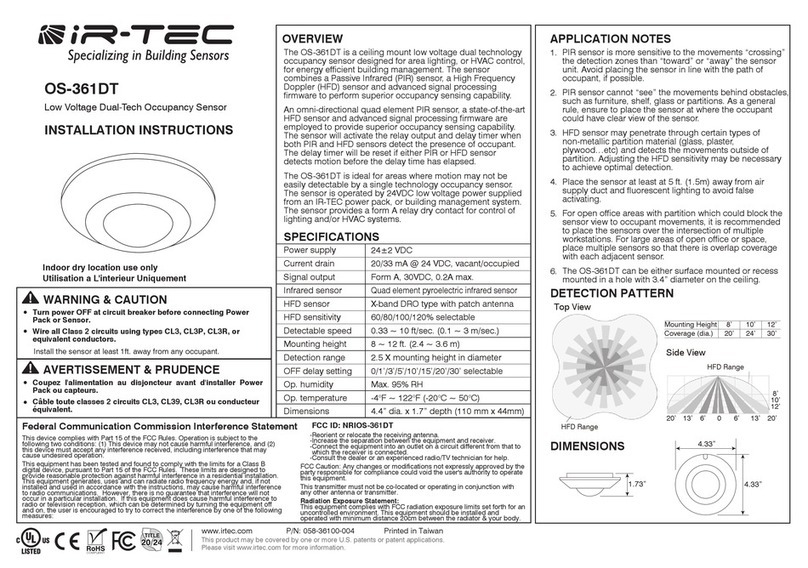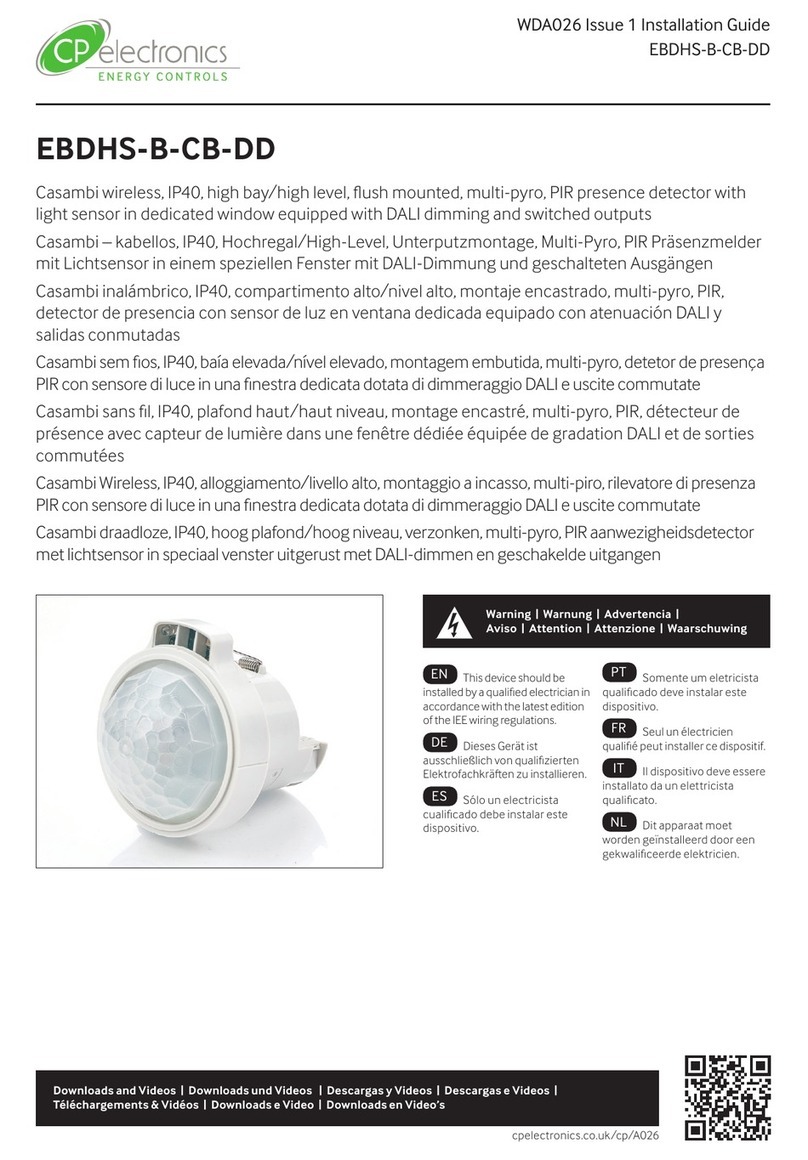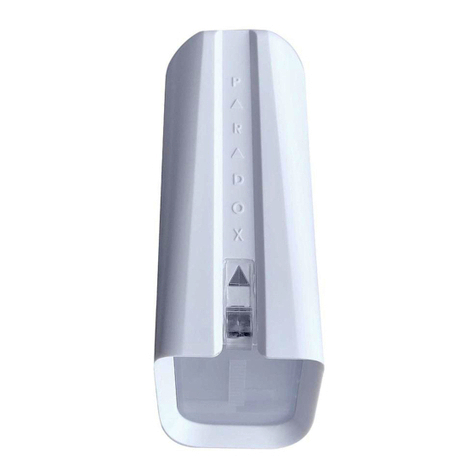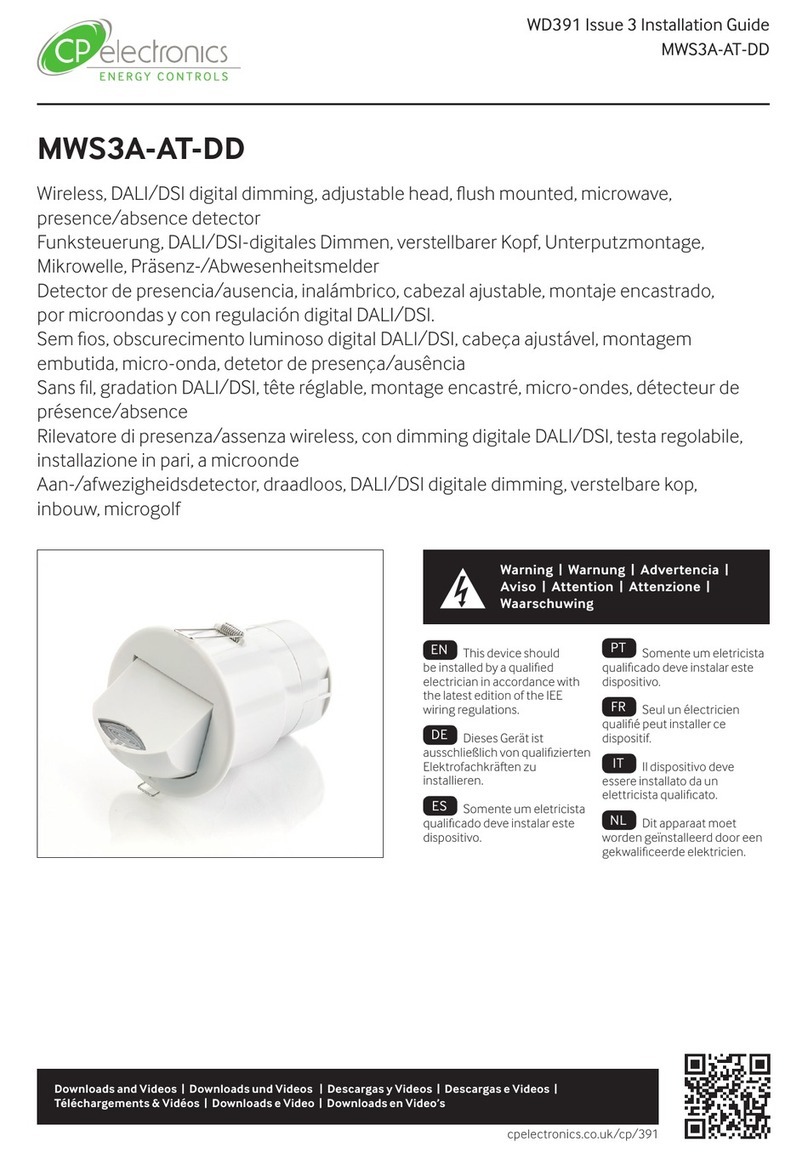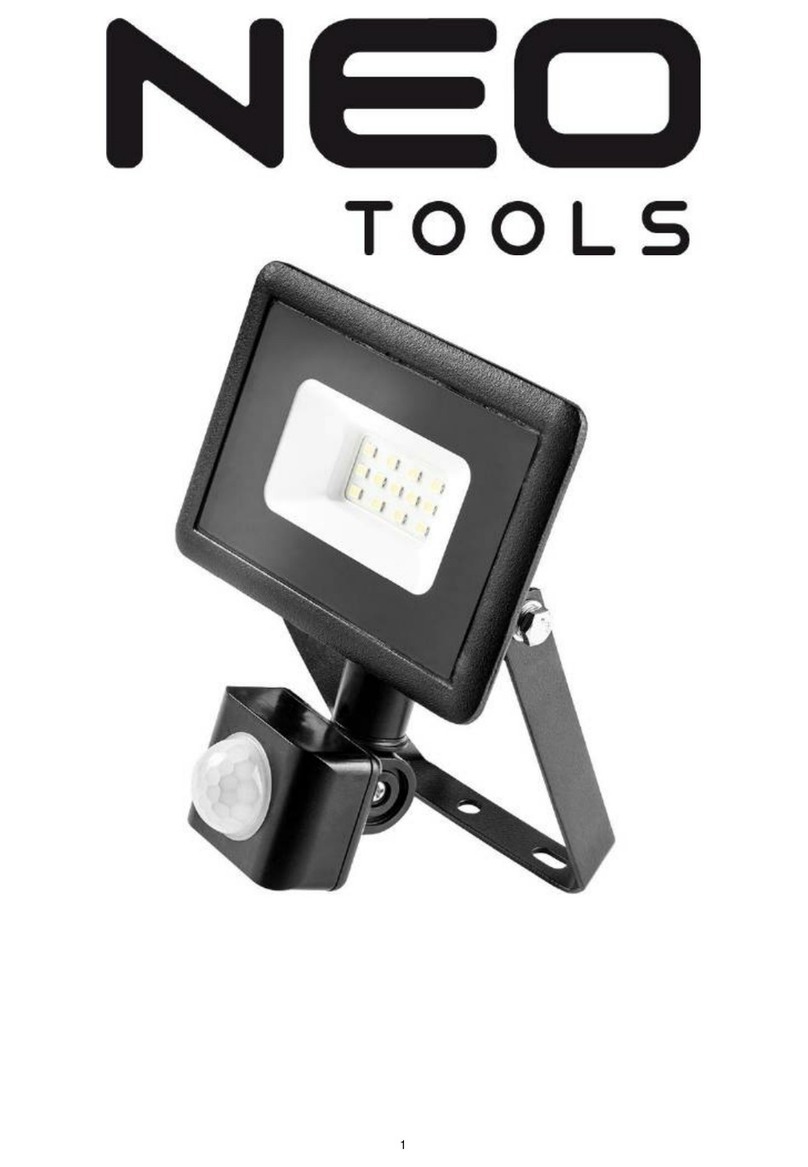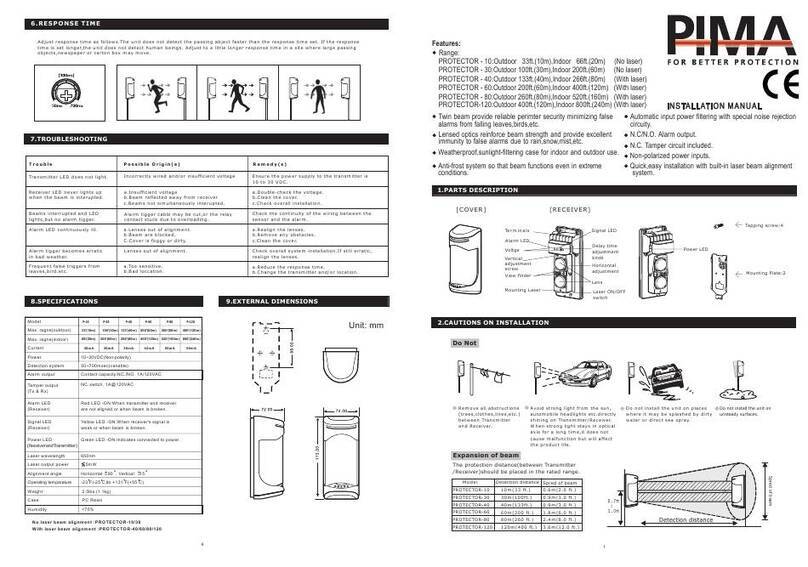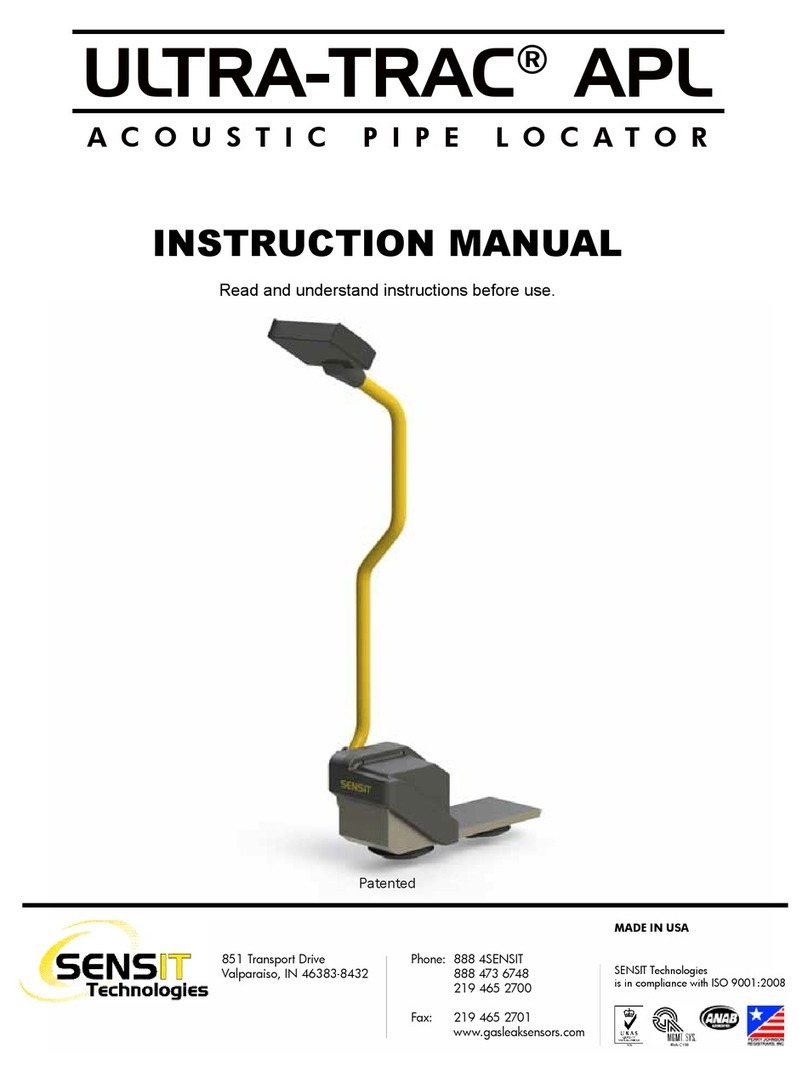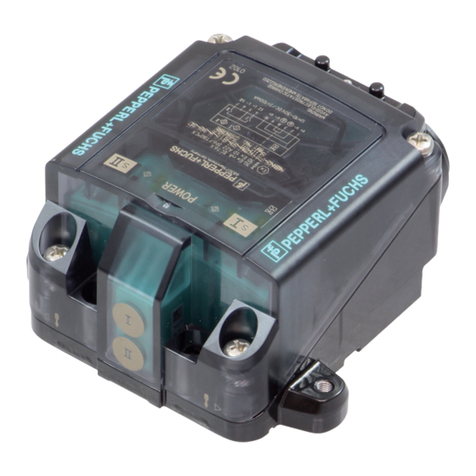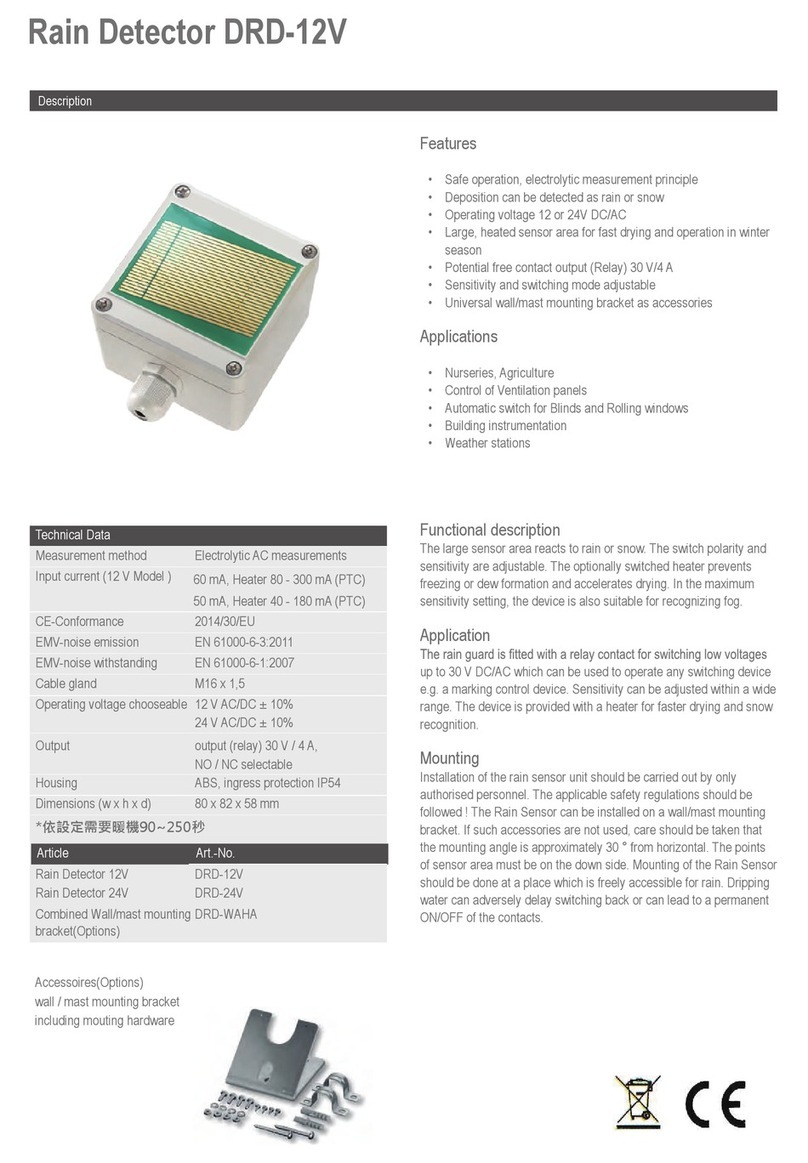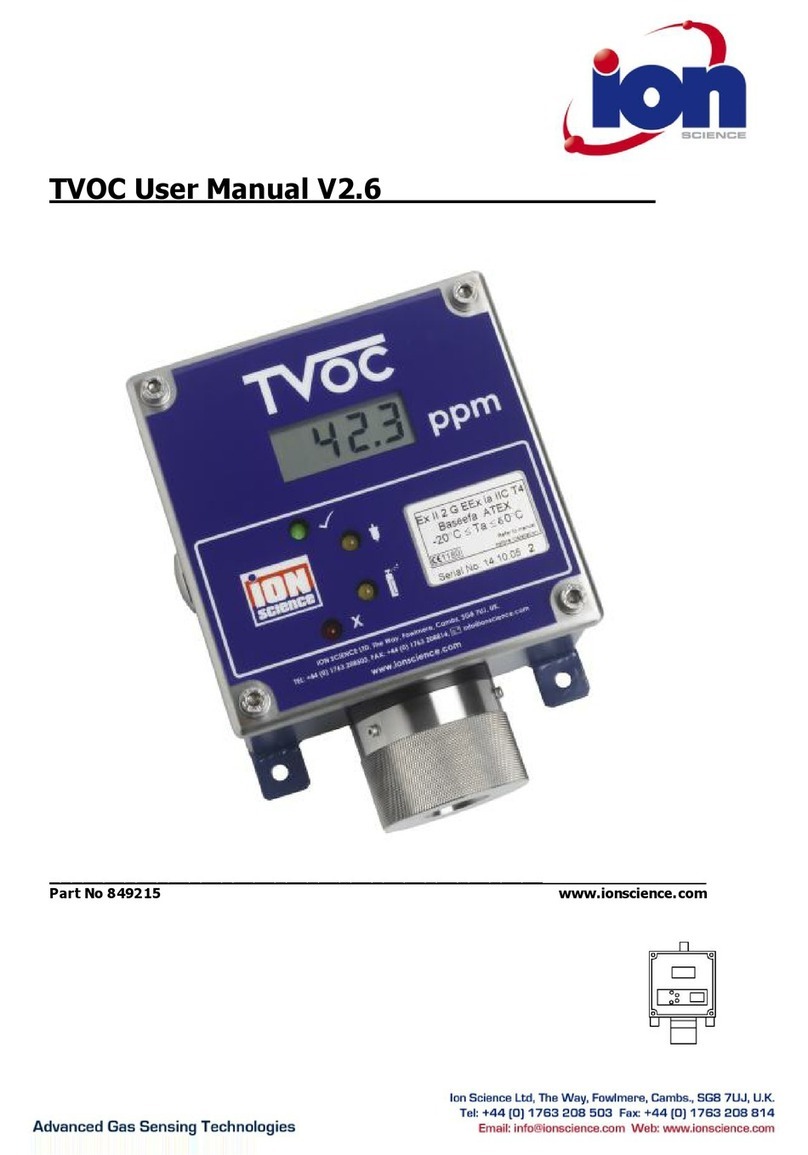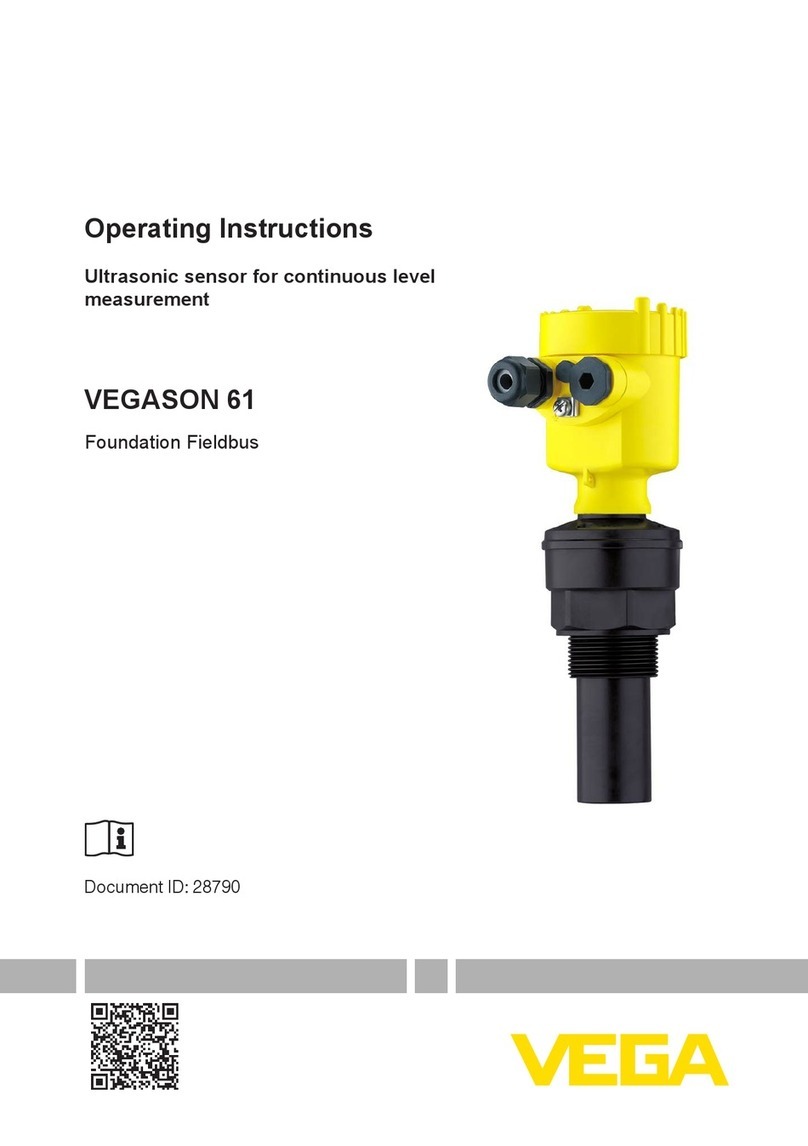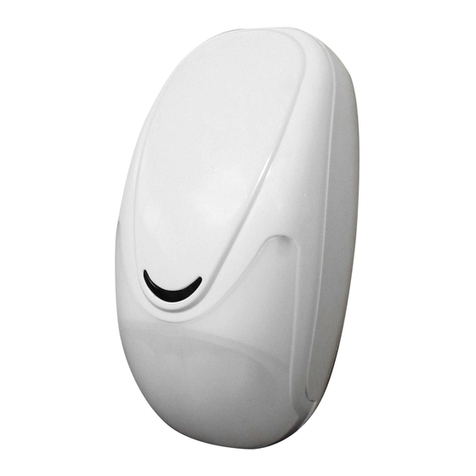Bornack SSE 02 User manual

User Manual
EN
EN 353-1:2014
SSE 02

|
SSE 02
Rope fall arrester SSE with sliding arrester
harness
BRIEF DESCRIPTION
INTENDED USE
In combination with a harness in compliance
with EN with a sternal attachment point,
the fall arrester SSE serves to secure persons
when climbing or descending e.g. auf pylons
with a stationary ascent in the shape of a verti-
cal ladder, or climbing facilities with step irons
etc.
The SSE safety system comprises a stationary
tensioned safety cable connected to the
structure and a sliding arrester harness (arres-
ter device) that can be used as required.
During the ascent, the user pulls the arrester
harness with him on the guide rope.
When descending, the arrester harness slides
ahead due to its weight. In the event of a fall,
the arrester harness blocks on the tensioned
safety cable and arrests the user safely.
An installed energy absorber on the arrester
harness limits the impact force to max. . kN.
The tensioned safety cable SSE is attached to
the TOP of a strong end attachment point.
A rope clamp for length adjustment and a
locking device are attached to the BOTTOM of
the end attachment point. An indicator spring
allows the rope tension to be controlled.
There are rope guides arranged at regular inter-
vals, through which the safety cable is placed
and is secured against sideward movement.
These rope guides can be passed freely by the
sliding arrester harness (arrester devicewithout
detachment and reattachment.
The rope guides and rope tension reduce the
risk of the rope swinging and the associated
rope wear.
Max. number of users: persons, clearance
min. . m.
Max. user weight incl. clothing and equipment:
. kg
Min. user weight incl. clothing and equipment:
. kg
Application temperature: +°C to -°C
The fall arrester SSE has been tested as
system and may only be used on an SSE-
tensioned safety cable! The SSE guide rope is in-
stalled in a stationary manner to the structure.
It may only be used by instructed personnel.
All other uses are deemed improper. The
company BORNACK will not be liable for any
ensuing damages. The user bears the sole risk.
Subject to technical changes

EN
EQUIPMENT FALL ARRESTER SSE02
• CNC-manufactured casing and element in
stainless steel
• Eccentric jammer in stainless steel
• Redundant eccentric jammer for panic bolt,
in stainless steel
• Side flanks made of plastic
• Rope guide prism to 'detach' the unit, one-
hand operation
• Automatically closing, dual lock
• Plastic rope centring
• Safety flap gate to prevent reversed wearing
• High-performance energy absorber belt with
shrink tube sheath, max. . kN also for kg
useful load
• Karabiner with swivel, Twistlock PLUS, triple
lock
• User manual
EQUIPMENT GUIDE ROPE SSE
• Stainless steel cable . mm, x with fork
terminal with toggle (guy rope ferrule with
fork-head)
• Rope guides SSE with connection plate, screw
attachment
• Rope tensioner with:
- Rope clamp for adjustment of the rope
length to the installation situation
- Pre-tension springs
- Indicator spring rope tension , kN
- Threaded spindle with clamping nut
ACCESSORIES
• Full body harness acc. to EN equipped
with two fall arrester D-rings on the front
(sternal D-ring at chest height, e.g. STRIPE. Full
body harnesses with elastic straps are not
compatible.
• Positioning rope MANUSTOP MS . m acc. to
EN or similar and/or
• Energy absorber rope PYTHON P . m acc. to
EN or similar
APPLICATION
• Securing against a fall via an arresting
function
USE
• Ascending and descending ladders e.g. on
pylons
• Climbing path equipped with stationary SSE
tensioned safety cable (see type plate)
BRIEF DESCRIPTION

|
Karabiner with
TWISTLOCK
PLUS lock
Pawl
Upper pushbutton of rope
prism to insert rope
Lower pushbutton of rope
prism to insert rope
Energy absorber belt
Rope guide
Pawl
Dropping latch
(prevents the
runner from
being positioned
back-to-front)
Moving fork
terminal
Bracket and label
Balance spring
Clamping nut
Rope clamp
Ground clamp
Safety rope
GUIDE ROPE SSE FALL ARRESTER SSE 02
Label
Crown
nut
TOP
BOTTOM

EN
INFORMATION BEFORE USE
The following checks must be
performed before each use!
• Damaged, fall-stressed, dubious fall arresting
equipment, devices or protective equipment
must be immediately withdrawn and not
used.
• The equipment may only be inspected by an
expert or the manufacturer.
• No independent changes or repairs may be
carried out.
VISUAL INSPECTION OF THE SAFETY CABLE
• Check the entire safety cable system during
every inspection: check that all components
are complete and fully functional.
Before starting:
- Rope is tensioned and not slack
- Clamping device and end attachment are
OK
- No irregularities apparent during visual
inspection toward the top of the mast
- Label is legible
During ascent:
- Safety cable does not rub (in particular on
the contact point with the rope guides)
- Rope guides are tight (no loose screws)
- No deformed rope guides
- No corrosion
• Swaging eye terminal at TOP shows no signs
of slippage or wear or corrosion.
• Crown nut is secured with a splint.
• All the screws of the end attachment TOP are
secured with a lock plate at the top.
• All screw connections are complete and tight.
Lock plates or lock rings (spring rings) are in
place.
• Metal parts, in particular the rope surface and
rope end connections, show no signs of
damage caused by deformation, breakage,
wear, heat (lightning strike) or chemical
influences.
• No deformation or cracks in the metal parts.
• No corrosion on the metal parts.
VISUAL INSPECTION OF THE FALL ARRESTER
• Check it is complete and fully functional.
• Metal parts show no signs of damage caused
by deformation, breaks, wear, heat, corrosion
of the eects of chemicals.
• No deformation or cracks in the metal parts.
• No corrosion on the metal parts.
• Textile parts (energy absorber belt) show no
signs of damage (wear, cuts, melting cause by
heat or the eects of chemicals).
• The last expert inspection took place less than
months ago (test label).
FUNCTION TEST
• All moving parts and joints in the personal
protective equipment run smoothly and do
not jam.
• The arresting equipment closes automatically
when placed onto the tensioned cable.
• The arresting equipment blocks when jerked
downwards.
• The arresting equipment cannot be attached
to the tensioned cable the wrong way round.
• The karabiner closes automatically after
opening.
• The label is legible.

|
SSE 02 IN USE
USE OF THE FALL ARRESTER EQUIPMENT
SSE
CAUTION:
Dubious or faulty systems may not be used and
should be reported centrally to the line mana-
ger. Document nonconformities and report
them to the manufacturer.
Putting on the full body harness
(observe User Manual of the harness)
A Attach the karabiner of the SSE to the
sternal attachment point (middle of chest) of
the full body harness. The attachment point
must be approved for the arresting function
(A-code).
Observe User Manual of the
harness
SAFE ASCENT O FTHE MAST
Climbing to the lower end of the securing
system SSE (approx. . – . m climbing
height).
Use PPE to secure against falling, e.g. energy
absorber lanyard etc.
Observe User Manual of the
respective PPE.
CAUTION:
Before using, ensure that there is enough space
below the user to prevent impact with a
protruding object or the ground.
CAUTION:
The length of the connection equipment
(fall arrester to full body harness) may not be
extended, e.g. by adding or removing a lanyard.
CAUTION:
When starting to climb close to the ground
(approx. . m), it is possible, in unfavourable
conditions, that the legs may come into contact
with the ground when a fall is arrested.
A A

EN
SSE 02 IN USE
ATTACHMENT OF THE FALL ARRESTER TO THE
TENSIONED ROPE
B Hold the unit in your hand so that the arrow
points upwards (if in the wrong position, the
dropping latch covers the insert slit for the
rope)
C Open pawl by lifting the energy absorber
belt.
D Press the pushbuttons of the rope prism
(unit lock) with your thumb and middle
finger: the prism opens itself.
• Press both buttons, pressing the upper
button first
• A slight twisting movement helps the unit
to open
This procedure can be carried out with just
one hand! It is designed for both left-handed
and right-handed operation!
E Place the fall arrester onto the guide rope.
CAUTION:
Check that the unit sits correctly on the rope!
• Prism is closed (basic setting)
• Unit runs freely during manual lifting and
lowering.
• Unit blocks when jerked downwards.
B
C D
E

|
SSE 02 IN USE
SAFE ASCENT AND DESCENT
• During ascent, the fall arrester runs freely.
• During descent the fall arrester slides.
• Its own weight automatically ahead on the
rope.
• The relatively heavy weight of the unit
ensures that it functions reliably.
When climbing, the upper body can be easily
shifted to the left or right.
F The upper body should be positioned on the
guide rope so that the karabiner is in a steep
position (' to ').
The further the upper body is tilted backwards,
the faster the arresting function triggers in the
event of a fall (the fall arrester responds more
quickly in case of a fall).
CROSSING THE ROPE GUIDE
• When crossing the rope guide, the fall arrester
must slide with its opening slit over the
bridge of the rope guide. To do this, the rope
guide must be approached as precisely as pos-
sible:
- No lateral movements of the body
- Position the upper body close to the direc-
tion of the guide rope
- Move the fall arrester fast and evenly up-
wards or downwards
F

EN
SSE 02 IN USE
• The following behaviour can lead to uninten-
tional faults:
- Fall arrester is twisted when placed onto the
rope guide and rubs on rope guide (braking)
- Upper body is leant too much backwards
(fall arrester blocks)
- Downward jerking (fall arrester blocks), fall
arrester can be released again by simply
lifting the karabiner
CAUTION:
Check that the unit has been attached correctly,
and that it is closed and locked.
Manual function test: jerk downwards!
• When positioning/working on the climbing
path:
• Also secure with a positioning rope and/or
energy absorbing belt. Do not work when only
secured via the fall arrester system!
• When crossing over: Before removing the fall
arrester SSE from the tension cable attach
the energy absorber belt to a secure attach-
ment point above the exit.
• Max. persons in the securing system at the
same time (guide rope).
• Safety clearance . m between person
climbing at the same time.
DETACHMENT FROM THE SECURING SYSTEM
CAUTION:
Only detach yourself from the fall arrester, if
there is no longer a risk of falling. If necessary,
attach a lanyard for temporary securing.
Repeat steps C-D. Remove unit from the rope.

|
There is a risk to life if these safety instructions
are not observed!
• If you have any problems with this equipment,
please just call the BORNACK hotline for help
• Vertical fall-arrest equipment and safety
equipment may no longer be used, even in the
case of very minor faults.
• Damaged, fall-stressed, dubious vertical fall-
arrest equipment, devices or protection equip-
ment must be immediately withdrawn and
not used.
• Inspection by an expert or the manufacturer.
Only use again after approval has been given.
Document the inspection in the test card.
• Independent modifications or repairs are pro-
hibited.
• The fall arrester SSE is part of the personal
protection equipment and should be assigned
to a specific person/team and must be inspec-
ted accordingly by a specially qualified expert.
• The stationary installed SSE securing ropes are
inspected by a specially trained expert
during every tour to ensure they are safe
(recommissioning of the SSE system). This per-
son must attend a user training course for
'authorised SSE persons' at BORNACK.
• The securing system must be inspected at
greater intervals by a technically competent
expert who has been trained by BORNACK in
how to inspect the SSE system. This inspection
must be documented.
• The protective equipment may only be used by
qualified sta who are familiar with the mate-
rial and have been briefed about the possible
risks associated with its use.
• In accordance with the accident prevention
guidelines (UVV), a theoretical training course
with a practical element for personal protecti-
ve equipment of Cat. is required. Make use of
the training competence of the BORNACK
training centres (see BORNACK hotline).
• Accessories from other manufacturers may
only be used, if they are compatible with this
safety equipment and have has been approved
by BORNACK.
• They may not impair the function and safety
of the protection equipment.
• Clothing and shoes must be suitable for the
task at hand and the weather conditions.
• Set the harness to your personal measure-
ments (including clothing).
• Only use the equipment if you are fully fit.
• A harness must always be used when this fall
protection system is used as an arresting
system (free fall). The total fall path must be
taken into account.
• Protect personal protective equipment during
storing, use and transportation against the
eects of heat (e.g. welding flames or sparks)
and chemicals (e.g. acids, alkalis) and mecha-
nical eects (e.g. loads, wear, sharp edges).
• Before starting work, the responsible person
must draw up an emergency plan (rescue
plan) which defines how to rescue casualties
quickly and safely from a vertical fall-arrest
system and ensures first aid is administered.
• The rescue operation must be completed
within a specific time period of between to
minutes, depending on conditions
• BORNACK can help you draw up tailor-made
rescue plans and will integrate these into
future training courses!
• The national / local safety guidelines (e.g. in
Germany the guidelines issued by the profes-
sional associations BGR and BGR ) and
the accident prevention guidelines for the
specific industry must be observed.
• Possible fall path if all required PPE compo-
nents are used correctly: brake path fall arres-
ter (max. cm) + (if necessary reaction time
HSG) + physical height (clear height of the
PPE) + safety reserve m.
SAFETY INSTRUCTIONS

EN
OTHER
CERTIFICATION
Complies with the EC Directive //EEC.
Type testing and production monitoring by:
DEKRA EXAM GmbH
Dinnendahlstr. , D- Bochum
CE
Quality management system certified accor-
ding to DIN EN ISO .
Production monitoring by Notified Body Cate-
gory III.
REGULAR INSPECTIONS
This equipment must be inspected and docu-
mented at least once a year or before use by a
specially trained expert.
SALES
The dealer must ensure that the user manual is
supplied in the language of the designated
country. The respective translation must be
authorised by BORNACK.
SERVICE
If you have any further questions about safe
use of this PPE or other BORNACK services, such
as:
• Risk analysis
• Rescue plans
• Training courses
• Expert inspections
please send your question to our e-mail hotline:
We will be happy to help!
MAINTENANCE
• Protective equipment that is well looked after
will last longer!
• This rope protection equipment does not
require any special maintenance.
• Special maintenance and inspection regulati-
ons apply to fall protection equipment (see
separate User Manual). As these devices need
to be opened for the inspection and readjust-
ment, they must be sent to an workshop
authorised by the equipment manufacturer.
• Observe metal parts with slight surface
corrosion and withdraw from use if necessary.

|
CLEANING
• Dry damp personal protective equipment in
the air, not on artificial heat sources. Dry
metal components with cloths.
• Brush soiled textile components (full body
harness, and ropes etc.) when dry or wet with
a brush or possibly with lukewarm water and
a little detergent for delicates. No other
cleaning agents may be used!
LIFE SPAN
Maximum usage period of fall arrester SSE
after being used for the first time:
up to years
• Textile components are subject to aging (brit-
tleness). Their service life can also be signifi-
cantly reduced, if exposed to temperatures,
chemicals and wear, and due to storage and
use!
• Arrange for the fall arrester SSE to be inspec-
ted by a trained expert at least once a year
and enter the inspection results into the test
card.
• On pylons: Always arrange for a qualified per-
son to check the securing rope SSE every time
before use, and then 're-commission'.
• It should be inspected and documented by a
trained expert at least once a year.
REPAIRS
• For reasons of liability, repairs may only be
carried out by the manufacturer.
• Only original spare parts from the manufactu-
rer may be used.
STORAGE
• Dry damp personal protective equipment
before storing.
• Store away from light in a dry place.
• Do not store rope protection equipment close
to radiators. Permanent temperatures of over
+ °C have a negative impact on the strength
of the textile material and will reduce the life
span.
• Do not allow personal protective equipment
to come into contact with aggressive substan-
ces (e.g. oils, grease, acids, chemicals).
• Store and transport the personal protective
equipment in the device case or device bag.
• The fall arrester equipment is generally made
of corrosion-resistant materials (stainless
steel, aluminium). Nevertheless, permeants
exposure to corrosive influences should be
taken into account (e.g. seawater atmosphere
or chemical influences).
TRANSPORT
Transport the personal protective equipment in
the device case or device bag.
OTHER

EN
PRODUCT IDENTIFICATION
You will find the following information on the fall arrester equipment:
Guide rope SSE
Label on mast foot
Guided-type fall arrester SSE
CE symbol
min.
5.0m
Steigschutzeinrichtung
OTHER
Contact
Contact
RFID
EN standard
Standards /
approval
Serial no. /
production date
Max. useful load
Min. / max. useful
load
Safety clearance
between users
Logo
CE symbol
Suitable fall
arrester equipment
Read/observe user
manual
Read/observe user
manual
Type designation
Type designation
Product type
Product type
Ident-No. / mounting date
Compatible
fall arresters
Logo
Climbing direction
upwards

|
The test card must be completed in full by
the expert during the annual inspection.
This test card does not claim to cover all
test criteria and does not relieve the expert
from his decision about the overall
condition.
TEST CARD
FOR ANNUAL MONITORING
_______________________________________________________________________
_______________________________________________________________________
_______________________________________________________________________
_______________________________________________________________________
_______________________________________________________________________
_______________________________________________________________________
_______________________________________________________________________
_______________________________________________________________________
_______________________________________________________________________
_______________________________________________________________________
_______________________________________________________________________
Year
Year
Year
Year
Year
Year
Year
Year
Year
Year
Date Signature
Next
inspection
Reason for inspection
Type SSE :
________________________
Manufactured on:
___________________
Serial no.:
_________________________
Purchase date:
______________________
Date of first use:
_____________________
Life span at the latest:
_________________

EN
TEST CARD
FOR ANNUAL MONITORING
Please complete:
Year
Year
Year
Year
Year
Year
Year
Year
Year
Year
No signs of corrosion
No signs of wear
Complete
No deformation, cracks etc.
Bearings have no play
Switch moves smoothly
Eccentric jammer blocked
(spring clamp)
BFD undamaged
Karabiner intact
Fastener lock OK?
User manual available?
Labels legible?
OK
Blocked

|
Notes:

EN
Notes:

|
Notes:

EN
Notes:

BORNACK GmbH & Co.KG
Bustadt 39
74360 Ilsfeld
Germany
Tel + 49 (0) 70 62 / 26 90 0-0
Fax + 49 (0) 70 62 / 26 90 0-550
info@bornack.de
www.bornack.de
BORNACK Schweiz
Oholten 7
5703 Seon, AG
Swiss
Tel + 41 (0) 62 / 886 30 40
Fax + 41 (0) 62 / 886 30 41
info@bornack.ch
www.bornack.ch
FALLSTOP
Safety equipment for securing and
rescuing at heights and depths
SAFEPOINT
Permanently installed safety systems
for architects and industry
© BORNACK – Subject to technical changes
Reprinting or duplication, even of excerpts, is only permitted with written consent
Status: 07/2018 GAL No. 000 097 ebo
Table of contents
Other Bornack Security Sensor manuals
